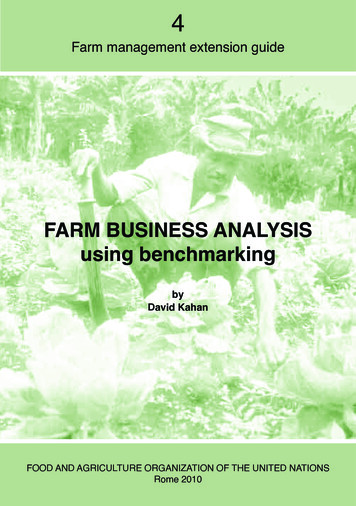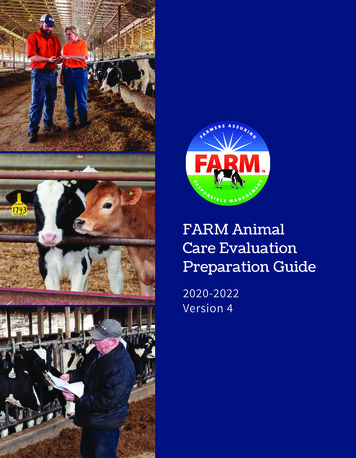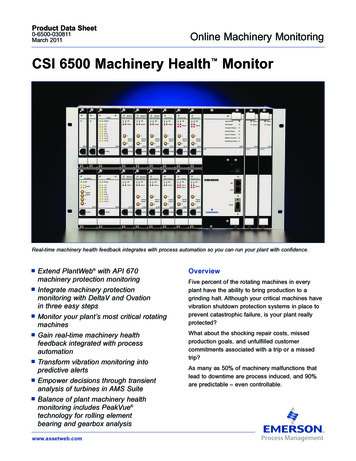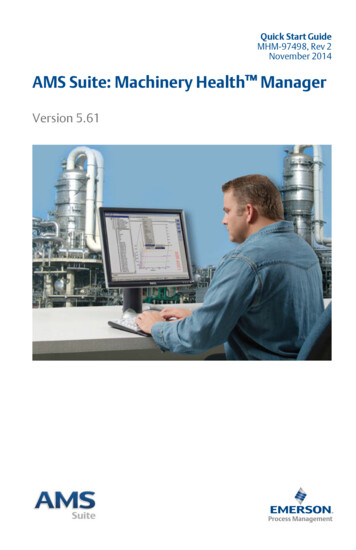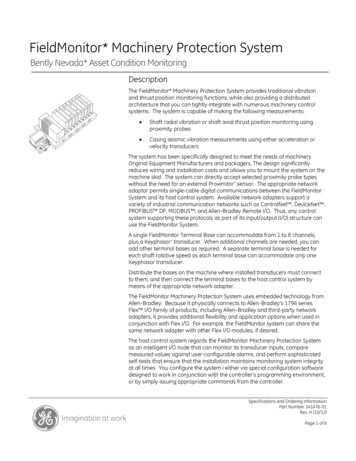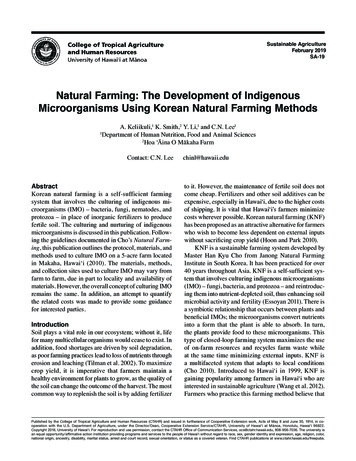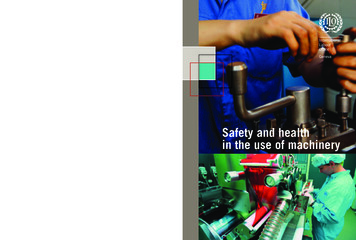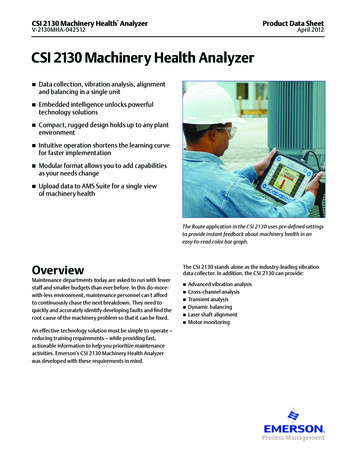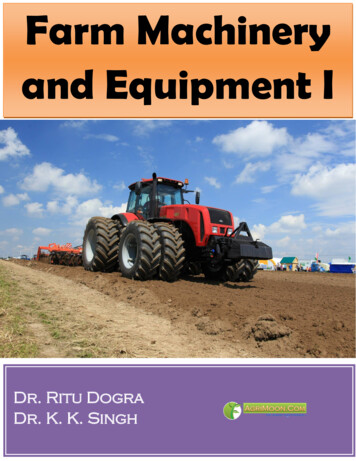
Transcription
Farm Machineryand Equipment IDr. Ritu DograDr. K. K. Singh
Farm Machinery and Equipment I-: Course Content Developed By :-Dr. Ritu DograAssociate ProfessorDepartment of Farm Machinery and Power Engg., PAU,Ludhiana-:Content Reviewed by :-Dr. K. K. SinghScientist, PDCSR (ICAR)Modipuram, Meerut (U.P)
IndexLessonLesson 1. Farm Mechanization: Introduction, objectives andlevel of mechanization in Punjab and IndiaLesson 2 Materials of construction of farm equipmentLesson 3. Heat Treatment of farm equipmentLesson 4. Selection of Farm MachinesLesson 5. Field capacity, efficiency, economics of machineryuse with numerical / problemsLesson 6. Field capacity, efficiency, economics of machineryuse numerical / problemsLesson 7. Tillage: objectives, methods and terminology,introduction and classification of primary & secondary tillageequipmentLesson 8. Study of mould board plough: accessories,adjustments, operation and material of construction MouldBoard PloughsLesson 9. Study of mould board plough: accessories,adjustments, operation and material of constructionLesson 10. Disc plough: standard and vertical ; principle ofoperation, adjustments and accessoriesLesson 11. Sub-soiler and chisel plough: types, working andconstructionLesson-12. Secondary tillage: objectives, implements, types,constructional features, working principles & operationLesson 13. Construction and working of Disc harrows, Spiketooth and spring-tine harrowsLesson 14. Construction and working of Disc harrows,Spiketooth and spring-tine harrowsLesson 15. Forces acting upon tillage tool/ implement andsymbols used in tillage force analysisLesson-16. Forces acting upon tillage tool/ implement andsymbols used in tillage force analysisLesson 17. Hitching System, Forces for Handling Implementsand Control of ImplementsPage 778-8182-8283-8788-9596-102103-108109-122
Lesson 19. Study of miscellaneous tillage tools, rotary tillagetools, rotavators, stirring plough, auger plough, rotary hoes,Oscillating tools etc.Lesson 20. Study of miscellaneous tillage tools, rotary tillagetools, rotavators, stirring plow, auger plow, rotary hoes,Oscillating tools etcLesson 21. Earth moving equipment (Bulldozer, Trencher,Elevator etc.): construction and working principlesLesson 22. Sowing methods and practices, functions andconstructional features of a seeding/ planting machineLesson 23. Seed metering devices for solid drilling and singlefarming, Furrow openers used in drills and plantersLesson 24. Calibration of seeding and planting machinesLesson 25. Planting mechanisms for potato and sugarcaneLesson 26. Transplanting machines for vegetables and paddy:working principles and constructional detailsLesson 27. Fertilizer application and broadcasting machineryand their calibrationLesson 28. Weeding equipment: power operated and manualRow crop cultivation equipmentLesson 29. Spraying and dusting equipment: atomising devices& pumps for sprayers, constructional 54-154155-157158-158159-164165-175
Farm Machinery and Equipment I.Lesson 1. Farm Mechanization: Introduction, objectives and level of mechanization inPunjab and IndiaSOURCES OF FARM POWER AND MECHANIZATIONVarious types of agricultural operations performed on a farm can be broadly classified as:1. Tractive work such as seed bed preparation, cultivation, harvesting and transportation,and2. Stationary work like silage cutting, feed grinding, threshing, winnowing and lifting ofirrigation water.These operations are performed by different sources of power namely, human, animal,stationary engine, tractor, power tiller, electricity, solar and wind. For doing these operationsdifferent types of power available is classified as: Human power Animal power Mechanical power Electrical power Wind powerHUMAN POWER: The indications are that the decline in number of labourers employed foragriculture is likely to increase in future resulting a greater investment in labour savingdevices and mechanical power.Labour (Human Energy) on Farms: Labour is one of the most important sources of farmpower in regions where traditional system of agriculture is practiced. On small farms, highproportion of labour is supplied by the farmer and his family. Only to meet the peak andpermanent labour requirements, the hired labourers are employed.On small farm having very little spare capital to buy appropriate type of hand tools andanimal drawn equipment, both labour use efficiency and productivity are very low. Labouruse efficiency can be improved by engaging labour in a group where sequence of operationsdemands teamwork for effective output. In the absence of the team, single man would wasteother energies, which might result into higher cost of operation. For example, a power thresheroperation always demands a team effort for efficient utilization of expensive resources i.e.,thresher, cleaner, the prime mover, etc.5
Farm Machinery and Equipment I.ANIMAL POWER: Animal power is the most important source of power on the farm all overthe world particularly in developing countries. It is estimated that nearly 80 per cent of thetotal draft power used in agriculture throughout the world is still provided by animals.Different animal sources are: Bullocks- can pull of about 15% of its weight Buffaloes Camels Horses Donkeys-can pull 80 % of its weight for short period and 10-15% of its weight forsustainable period. mules and elephantsThe average force a bullock can exert is nearly equal to one tenth of its body weight. But for avery short period, it can exert many more times the average force. Generally a medium sizebullock can develop between 0.50 to 0.75 hp.MECHANICAL POWERThe third important source of farm power is mechanical power that is available throughtractors and stationary engines. The engine is a highly efficient device for converting fuel intouseful work. The efficiency of diesel engine varies between 32 and 38 per cent, whereas that ofthe petrol engine in the range of 25 and 32 per cent. In recent years, diesel engines and tractorshave gained considerable popularity in agricultural operations. Small pumping sets within 3 to10 hp range are very much in demand. Likewise, engines of low to medium speed developingabout 14 to 20 hp are successfully used for flourmills, oil expellers etc. Diesel engines of thelarger size are used on tractors. Diesel engines are the main source of power in agriculture. Thebasic reason for their preference is the economy in operation.ELECTRICAL POWERNow-a-days electricity has become a very important source of power on farms in variouscountries. It is steadily becoming more and more available with the increase of various rivervalley projects and thermal stations. The largest use of electric power in the rural areas is forirrigation and domestic water supply. Besides this, the use of electric power in dairy industry,cold storage, fruit processing and cattle feed grinding has tremendously increased.WIND POWERThe availability of wind power for farm work is quite limited. Where the wind velocity is morethan 32 km/h, wind mills can be used for lifting water. The most important reason of its low6
Farm Machinery and Equipment I.use is its uncertainty. Thus the average capacity of a wind mill would be about 0.50 hp. It isone of the cheapest sources of farm power available.MECHANIZATIONAGRICULTURAL MECHANIZATION involves the design, manufacture, distribution, useand servicing of all types of agricultural tools, equipment and machines. It includes three mainpower sources: human, animal and mechanical with special emphasis on mechanical (tractivepower).FARM MECHANIZATION: is technically equivalent to agricultural mechanization but refersto only those activities normally occurring inside the boundaries of the farm unit or at the farmunit level (example: village, community, co-operatives etc).TRACTORIZATION: refers to the application of any size tractor to activities associated withagriculture.MOTORIZATION: refers to the application of all types of mechanical motors or engines,regardless of energy source, to activities related to agriculture.AGRICULTURAL IMPLEMENTS: are devices attached to, pulled behind, pushed, orotherwise used with human, animal or mechanical power source to carry out an agriculturaloperation.AGRICULTURAL MACHINERY: is a general term used to describe tractors, combines,implements, machines and any other device more sophisticated than hand tools which areanimal or mechanically powered.AGRICULTURAL EQUIPMENT: generally refers to stationary mechanical devices such asirrigation pump-set.SCOPE OF MECHANIZATIONIt is quite true that the farmers of developing countries have the lowest earnings percapita because of the low yield per hectare they get from their land holdings. One of the fewimportant means of increasing farm production per hectare is to mechanize it. Mechanizationmay have to be done at various levels. Broadly, it can be done in three different ways:I. By introducing the improved agricultural implements on small size holdings to be operatedby bullocksII. By using the small tractors, tractor-drawn machines and power tillers on mediumholdings to supplement existing sources.III.By using the large size tractors and machines on the remaining holdings to supplementanimal power source.7
Farm Machinery and Equipment I.As a matter of fact, the progress of the country should be mainly judged on the basis ofdegree of farm mechanization (production per worker and the horsepower under hiscommand per unit area).Large amount of labour or draft power, which can be replaced through machines, provides astrong incentive to mechanize.From the energy application point of view, the Indian agriculture is in the transition from:Stage 1 (human power) and stage 2 (animal power) toStage 3 and 4 (power tiller or four wheel tractor).FARM MECHANIZATION:Farm mechanization is the application of engineering and technology in agriculturaloperations, to do a job in a better way to improve productivity. This includes developmentapplication and management of all mechanical aids for field production, water control,material handling, storing and processing. Mechanical aids include hand tools, animal drawnequipment, power tillers, tractors, engines, electric motors, processing and hauling equipment.SCOPE OF FARM MECHANIZATION:There is a good scope of farm mechanization in India due to the following factors:1)Improved irrigation facility in the country.2)Introduction of high yielding varieties of seeds.3)Introduction of high dose of fertilizers and pesticides for different crops.4)Introduction of new crops in different parts of the country.5)Multiple cropping system and intensive cultivation followed in different parts of thecountry.SOME OTHER FACTORS WHICH ARE RESPONSIBLE TO ENCOURAGEMECHANIZATION ARE:FARMi) Population of the country is increasing at the rate of about 2.2% per year. Steps have to betaken to arrange food and fibre for such large population by adopting intensive farming in thecountry. Intensive farming requires machines on the farm.ii) In multiple cropping programme, where high yielding variety of seeds are used, all farmoperations are required to be completed in limited time with economy and efficiency. This ispossible with the help of mechanization.8
Farm Machinery and Equipment I.iii) Farm mechanization removes drudgery of labour to a great extent. A farmer has to walkabout 66 km on foot while ploughing 1 ha land once by bullocks with a country plough having15 cm furrow width.iv) A large number of females and children work on farm. So, with mechanization females canwork at home and children go to school.v) The proper utilization of basic inputs like water, seeds and fertilizers will be possible withproper equipment.vi) There are certain operations which are rather difficult to be performed by animal poweror human labour such as:a) Deep ploughing in case of deep rooted crops.b) Killing the pernicious weeds by deep tillage operations.c) Levelling of uneven land.d) Land reclamation.e) Application of insecticides during epidemic seasons. These operations need heavymechanical equipment.BENEFITS OF FARM MECHANIZATION:There are various benefits of farm mechanization:1) Timeliness of operation2) Precision of operation3) Improvement of work environment4) Enhancement of safety5) Reduction of drudgery of labour6) Reduction of loss of crops and food products7) Increased productivity of land8) Increased economic return to farmers9) Improved dignity of farmers10) Progress and prosperity in rural areasPRESENT STATUS OF FARM MECHANIZATION:9
Farm Machinery and Equipment I.Present status of farm mechanization is quite appreciating. We have:a) Improved manual tools.b) Improved animal drawn implements.c) Tractor operated implements.d) Custom hiring units on the farm.e) Other stationary equipments like threshers, irrigation pumps, sprayers, dusters etc.LIMITING FACTORS IN FARM MECHANIZATION:There are various limitations in adopting farm mechanization:1) Small and fragmented land holdings.2) Less investing capacity of farmers.3) Agricultural labour is easily available.4) Adequate draught animals are available in the country.5) Lack of availability of suitable farm machines for different operations.6) Lack of repair and servicing facilities for machines.7) Lack of trained man power.8) Lack of co-ordination between research organization and manufacturers.9) High cost of machines.10) Inadequate quality control of machines.India has made impressive strides in the field of agriculture by enhancing agriculturalproduction from a mere 51 m-tons in 1950-51 to 258 m-tons by 2011-2012. This has beenachieved through the adoption of biological, chemical and mechanical inputs and bycreating/promoting required infrastructure and facilities in rural areas. Appropriate Govt.policies such as consolidation of holdings, land levelling, rural roads, and establishment ofgrain markets, rural electrification, adequate credit and assured minimum support price havehelped in this phenomenal increase in agricultural production and productivity. India‟s wellorchestrated Green Revolution has done the nation proud. Beginning the mid sixties, India haswitnessed many revolutions which have put our agrarian economy on a sound footing. Theseinclude Green Revolution, white revolution, blue revolution & grey revolution. The last namedrevolution is synonymous with machinery revolution. However, the Indian green revolution isgradually fading. The yields have reached a plateau. The country is now in search of a rainbowor evergreen revolution.10
Farm Machinery and Equipment I.Indian agriculture is plagued with many problems such as low productivity in rainfed areas,decline in soil fertility, receding water tables, change in ecology due to monoculture andindiscriminate use of resources, increasing environmental pollution, staggering losses ofperishables (30-40 %), absence of scientific post harvest infrastructures, inadequacy of energyfor production and post harvest agriculture, low exports, due to low quality and high cost ofproduction, as well as non-conformance to global quality assurance and management norms.The WTO regime has created an urgency to bring about a paradigm shift in Indian agricultureand mindsets of all concerned. Ecologically sustainable agriculture by adopting conservationfarming together with diversification of agriculture in problem areas, greater privateinvestment and setting up chains of agro-processing centres in the rural areas are the newfocus of Indian Agriculture. The country has about 60 million tonnes of wheat and paddy inthe central food reserve and to avoid further complications and wastage, urgent steps need tobe undertaken to promote exports and provide food to nearly 40% of the population whichdoes not have economic access to food, even though the county has plenty of it in the reserve.In the sixties and early seventies debates were often held by the policy makers, economists,sociologists, engineers and all those concerned with agricultural modernization regardingrelevance of agricultural mechanization in a labour abundant economy. Literature is repletewith studies commissioned by the Planning Commission through National Council of AppliedEconomic Research (NCAER), SAU‟s and other bodies to find out the impact of agriculturalmechanization on agricultural productivity, cropping intensity, labour employment andreturns to the farmers. These studies conclusively proved that adoption of tractors & farmmechanization led to significant increase in cropping intensity, increase in production &productivity and reduction in the cost of production. For certain operations like harvesting,use of machines did displace the labour but taking into account direct labour on the farm,indirect labour employed for manufacturer, repair, maintenance and subsidiary labour, farmmechanization led to higher employment generation. Timeliness of operations, precision,better quality of operations, accurate placement, uniform distribution, reduction in losses,better quality of produce, reduced cost of production, reduction in drudgery to human beingsand animals and enhancing the dignity of labour are the major advantages offered by farmmechanization. It is now agreed that introduction of tractors & machines has also helped tocheck migration of educated youth, skilled and unskilled man power from the rural to urbanareas.Notwithstanding the wide agro ecological diversity, variation in soil types, climate,precipitation, irrigation intensity, cropping systems, land topography and industrialinfrastructure, India has done remarkably well in mechanization of Agriculture. We haveevolved a unique model by way of selective mechanization where in we have utilized both theanimate and inanimate sources of farm power namely, human labour, draft animals, tractors,diesel engines and electric motors, The country‟s farmers presently employ over 205 millionagricultural labourers, 63 million pairs of draft animals, 3.0 million four wheel tractors, 110000power tillers and over 18 million irrigation pumps, One of the commonly used indicators toexpress the level of mechanization of agriculture in a state/country is the availability of farmpower per unit area (kW/ha). For India, it stands at 1.12 kW/ha and that for the mostmechanized state of Punjab, at 2.96 kW/ha, followed by 2.33 kW/ha for Haryana, 2 kW/ha forTamil Nadu and 1.48 kW/ha for UP. Table 1, gives the power availability, irrigation intensity,11
Farm Machinery and Equipment I.cropping intensity and yield for different states in India, which clearly demonstrates that stateswith higher power availability per ha also have higher yields per hectare.FAO publishes a Year Book each year which gives the number of tractors and harvesters per1000 ha for all countries and continents. For India, the number of tractors available as of now is14 tractors /1000 ha as against 82 tractors per 1000 ha for the state of Punjab. Indeed, Punjaboccupies a place of pride in the development and introduction of farm mechanizationtechnology in India. The beginning was made with the use of stationary power sources(engines and electric motors for pumps, tube wells and threshers) in the late fifties followed bymobile power sources like tractors and combines for a wide range of field operations fromland preparation to crop harvesting. India‟s first power thresher was innovated in Punjab in1957, so also the animal and tractor operated seed drills, potato planters and diggers,sunflower thresher, seed planters, sugarcane planter, strip till drill, high clearance sprayer,straw combine, various types of weeders, cleaners, graders & vegetable seed extractingmachines. Mechanization of a crop or operation always begins from Punjab and spreads firstto the adjoining states and later to every nook & corner of India. The role of Agriculturalengineers, manufacturers & farmers in mechanizing agriculture is commendable.Table 1: Power availability, cropping intensity, percent irrigated area, fertilizerconsumption and grain yield for different states in lentyield (ton/ha)Jammu .33202.51.683.63Rajasthan42129.30.5339.21.200.9312
Farm Machinery and Equipment .51.381.91West rnataka80224.90.8090.21.151.58Tamil 1.361.45Total88038.31.0297.61.321.96Source: Singh, G., 2001, Relationship between mechanization and agricultural production invarious parts of India, AMA: 32(2), 68-76.One can better appreciate the Indian farm mechanization scenario by looking at the extent ofmechanization of various crop production operations such as seed bed preparation, sowing &planting, weed & pest control harvesting, threshing & post harvest operations. According tothe estimates prepared by Ministry of Agriculture, tillage is mechanized to the extent of 37%,sowing and planting 63%, threshing 20%, irrigation 54%, plant protection 43% and harvesting2%. Hence there is ample scope for further mechanization of Indian agriculture.India is today the largest tractor producing nation of the world with an installed capacity ofover 4.79 lakh tractors per year. As many as 2.2 to 2.5 lakh tractors are manufactured and sold13
Farm Machinery and Equipment I.in the country every year. Apart from 15 tractor manufacturing firms, there are about 3500farm machinery manufacturers, over two dozen colleges and departments of agriculturalengineering, one Central Institute of Agricultural Engineering at Bhopal, One Central Instituteof Post Harvest Engineering and Technology at Ludhiana and four Farm Machinery Trainingand Testing Institutes located in different parts of the country. All these agencies are engagedin R&D, testing and evaluation as well as commercialization of various types of equipment.BOTTLENECKS IN INDIAN FARM MECHANIZATION SYSTEM Low annual use of tractors (only 500-600 hrs/year against recommended 1000hrs/yr). Non availability of matching equipment. Cumbersome and energy inefficient designs. Poor reliability, frequent breakdowns and high repair and maintenance cost. Low quality. Use of ungraded materials, absence of inter-changeability of components. Inadequate R&D, Testing &Training facilities and inadequate Research funding. Inadequate user education. Lack of standardization. Non-availability of relevant literature like operator‟s manual, parts catalogues etc.PRIORITY AREAS FOR INDIAN AGRICULTURAL MECHANIZATION Intensification of R & D to introduce energy efficient machines for relatively unmechanized crops such as cotton, sugarcane, oil seeds, pulses, vegetables & fruits. Usereverse engineering and enforce close collaboration with farm machinerymanufacturers. Assist Indian manufacturers in seeking collaboration with well knownforeign firms wherever desired engineering technologies are not available. Intensify research in the area of tractor design engineering due to their extensive use inIndian farming. India is now the largest tractor manufacturer in the world. TMA needsto be involved in this task. Farm machinery management research to find out use patterns, annual usage,breakdown frequencies, repair & maintenance cost and above all reliability. Research on safety, comfort, exhaust emissions and health hazards in the use ofmechanical power sources and machines needs to be expedited.14
Farm Machinery and Equipment I. Emphasis be laid on conservation farming and energy saving/energy efficient tools andmachines. An area of utmost importance from environmental point of view is proper utilization ofabout 540 million tonnes of crop residues available in India. Punjab alone has 10 milliontonnes paddy straw which is mostly burnt. Burning needs to be banned. Appropriatemachines for incorporation of residues into the soil, for mulching, for collection,handling & transport for briquetting, gasification, power generation, and/or alliedusage is a priority area in the field of mechanization. Research on alternate engine /tractor fuels including bio-diesel, ethanol, producer gasneed to be intensified. Greater emphasis be laid on design and manufacture of high capacity and precisionmachines for multi farm use, for corporate/contract farming as well as for customhiring through Agri. Business Centres being promoted by Govt. of India for the benefitof rural youths. Equipment for post harvest transport, bulk handling, cleaning grading drying millingpackaging and storage are urgently required. These could be imported wherever nonexistent. Next revolution in agriculture must be ushered in the area of efficient foodprocessing & agro industries to transform the rural areas & utilize the surpluses.Mechanization packages will be crucial to ensure success of contract/corporatefarming. Mandi mechanization with a view to introduce bulk handling of grains is an urgentneed. Mechanization of hill-agriculture (20% total cultivated area), horticulture andfloriculture, forage production and handling equipment, forestry mechanization, andefficient transport equipment are some important areas. Women-friendly tools and gadgets need to be evolved by modifying the existing onesand designing the new tools to reduce drudgery to women workers. Mechanization of experimental plots is an important area requiring urgent attention. Amission mode project under the NATP has recently been sanctioned in this area. Nearly two-third of the cultivated area is rainfed. Farm power available in these areas isbarely 0.3 kW/ha. Hence, mechanization of these areas should be under taken onpriority basis. Large horse power tractors and suitable equipment for conservation ofsoil moisture, seed bed preparation, seeding/planting, harvesting etc., are required. The benefits of farm mechanization have so far remained confined to mainly wheatbased cropping systems. These need to be expanded to all cropping systems includinghorticulture.15
Farm Machinery and Equipment I. The present credit policy based on land mortgage is not favourable to small farmers toown mechanical prime movers. It excludes them from the benefits of farmmechanization and supplementing their incomes through hiring out their spareoperational capacity. Instead of land mortgage, viability and hypothecation of themachinery may be better criteria. There being a positive relationship between power availability and agriculturalproductivity, power constraint should be removed. An annual growth rate of 4% over1996 base in power supply to raise it from 1kW/ha to 2kW/ha by 2020 will be adequateto maintain a growth rate of 3% or more in agricultural production. This is based on“power-production relation” studies in India and abroad. The additional power will besupplied by tractors, power tillers, self-propelled machines, engines and electric motors. For precision farming, precision equipment for planting and plant protection arerequired. Increasing emphasis on Integrated Pest management and Organic farming wouldrequire use of efficient cultivation machinery for weeding and hoeing. Research in thisarea would be necessary to evolve optimum planting geometry and practices. Under the WTO regime with liberalization of markets foreign countries might takeadvantage of dumping their machinery in India, especially such equipment as sugarcane harvesters, paddy transplanters, potato combines, cotton pickers, horticulturalmachinery, sprayers unless required equipment are expeditiously developedindigenously and have cost and quality competitiveness. Joint projects by R&Dorganizations and Indian firms would be desirable.SUGGESTIONS FOR FURTHER IMPROVEMENT1. No Farm Machinery research/development project should be initiated withoutconducting a market survey to assess the client needs and perceptions.2. Greater industry-institution collaboration by undertaking joint research projectsand use of reverse engineering would be helpful for speedy development andcommercialization of new equipment.3. Computer Aided Design (CAD) must be used for optimum design, cost reductionand reliability. All R&D organizations must have a CAD facility with latest designpackages. Train R&D engineers to develop proficiency in computer aided design.4. R&D engineers must ensure compatibility of their designs with BIS/ISO standards,norms and practices.5. Standardization of critical components to ensure quality, durability and interchangeability is essential.6. Up gradation of manufacturing technology to upgrade quality and reduce the cost.16
Farm Machinery and Equipment I.7. It is under stood that a proposal is afoot to establish a Farm Mechanization Instituteunder the auspices of the Ministry of Agriculture and Co-operation. This institutewill intensify research on different aspects of Farm Mechanization includingtechno-socio-economic aspects with a view to develop a long range FarmMechanization Policy. A Draft Agricultural Mechanization Policy has already beenevolved and it awaits approval of the government. Since bulk of tractor and farmmachinery manufacturers are located in the northern states of India, it might bedesirable to locate such an apex institution in the Punjab, as this state in spite ofbeing one of the most mechanised states in the country, has just one ICAR institute,whereas her neighbouring states have 2 to 3 ICAR/central institutes.To sum up, it may be concluded that farm mechanization is a dynamic technology. It evolveswith changes in agriculture in a region/state/country. With di
Farm Machinery and Equipment I. 6 ANIMAL POWER: Animal power is the most important source of power on the farm all over the world particularly in developing countries. It is estimated that nearly 80 per cent of the total draft power used in agriculture throughout the world is still provided by an


